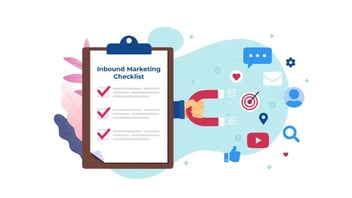Generate More Website Traffic: Expert Strategies Revealed
Want to increase traffic to your website? This article aims to help you build a cohesive strategy to do just that. Our intent is not to provide a comprehensive list of everything you should be doing but rather to show some possibilities you can test so you'll see what works best for you and your audience.
Why Does it Matter?
-
70% of businesses say generating traffic is their top online marketing challenge. With so much competition for attention in the online space, businesses must be innovative to stand out and capture the audience's attention.
-
Organic search is the number one driver of website traffic, accounting for 53% of all traffic. To dominate the online competition, businesses must prioritize optimizing their website for search engines.
-
Social media can also be a great way to generate traffic, with 33% of businesses reporting that it is a top traffic driver. However, using social media strategically and creating content relevant to your target audience is critical.
-
Email marketing is another effective way to generate traffic, with 27% of businesses reporting it as a top traffic driver. Email marketing allows you to reach out to your existing customers and promote your website to them.
-
Paid advertising can also be a great way to generate traffic, but it's essential to use it wisely. Paid advertising can be expensive, so it's important to target your ads carefully and ensure they are relevant to your target audience.
All website traffic is not created equal. To step up your Inbound Marketing and associated Lead Generation, you want high-quality traffic that is carefully targeted. High numbers are good, but those high numbers are vanity metrics unless that traffic converts. Here are some ways to step up your digital marketing and increase website traffic.
1. SEO: On-Page, Local, Technical
Use your core target keywords in your headline, article, or post, and image file names, and make your URL SEO-friendly by using keyword synonyms.
Optimize local search by including your city or state in your target keywords. Also, optimize for mobile to aid those rankings. Images should have effective alt tags to improve their discoverability. Make meta descriptions and title tags easy to read and compose so they don't get truncated (Google displays 155 characters of your meta description in search results).
The technical side of SEO focuses on the backend of your site and includes elements like page speed, crawling, and indexing. Check for and fix broken links and redirects to avoid the dreaded "404" error, create an XML sitemap for your subdomains, set up language meta tags, and add custom H1 and introductions to support the bots that crawl your site for search purposes.
How-to tip: Use relevant keywords throughout your website content.
When you're writing content for your website, it's important to use relevant keywords throughout your content. This will help search engines index your website and rank it higher in search results.
Example: Let's say you're a business that sells shoes. Some relevant keywords for your website could be "shoes," "sneakers," "athletic shoes," and "running shoes." You could use these keywords in your website's title tags, meta descriptions, headers, and content.
2. Social Media
Connect and engage with your audience on a platform they're already spending time on. Be active and connect with others in your niche. Become part of the community. If you just shout into the void by posting content, you'll never develop the traction to drive that traffic to your site.
You can't just barge into the ongoing conversation and ask people to buy something or visit your website. First, you need to provide value and develop goodwill. Here's where content marketing fits in. But, again, you can't just push out the content; you have to communicate with the audience.
Incorporate social media buttons to make it easier for visitors to share your content with their network. Social media sharing buttons automatically generate a link and use the blog post's title so it's easy for readers to customize and share with their audiences.
How-to tip: Use social media to connect with your audience.
Social media is a great way to connect with your audience and build relationships. Social media lets you share your content, interact with your audience, and learn more about their needs and interests.
Example: Let's say you're a business that sells running shoes. You could use social media to connect with your audience by:
-
-
-
Sharing photos and videos of your products
-
Answering questions from your audience
-
Running contests and giveaways
-
Promoting your blog posts and articles
-
-
3. Guest Posting
When you do a guest post, you can link to your website while showing you're active in the community. Find a site that fits your company well and accepts guest posts. Develop a pitch to present to appropriate blogs you'd like to have published your post.
You will get more consideration if the pitch shows you've done your research. Be respectful when approaching sites you'd like to guest post on. Follow the instructions they provide in their editorial guidelines when you submit your pitch. A cold approach is only acceptable if you cannot find these guidelines.
You should explain how and why your piece will appeal to their readers in your pitch. Maybe point out a gap in their content (carefully and graciously) and then describe how your piece fills it. Don't compete with their existing content or be competitive in your pitch. Should you get something published, answer any questions relating to your piece.
How-to tip: Write a compelling guest post pitch.
When pitching a guest post to a blog, it's essential to write a compelling pitch. Your pitch should include the following:
-
-
A catchy headline
-
A brief overview of your topic
-
Why your topic is relevant to the blog's audience
-
Why you're the best person to write about this topic
-
Example: Let's say you're a business that sells shoes. You could write a guest post pitch to a blog that covers fashion and style. Your pitch could include the following:
-
-
-
Headline: 5 Ways to Choose the Right Running Shoes
-
Overview: In this post, I'll share five tips for choosing the right running shoes. I'll cover factors like your foot type, running goals, and budget.
-
Relevance: This topic is relevant to the blog's audience because it's about fashion and style. It's also relevant to the blog's target audience because it's about running shoes.
-
Expertise: You're an expert on running shoes because you own a shoe business. You've also run marathons and half-marathons, so you have firsthand experience choosing the right running shoes.
-
-
4. Commenting
You can leave comments on other sites to generate traffic to your site. Start by finding sites that post content related to your niche. You can gain visibility and conversions by commenting on relevant industry blogs instead of gaining visitors. Be sure you're adding something worthwhile to the discussion.
Avoid embedding links in your comments to avoid sounding like you're attempting to plant your flag on their lawn. You can use your site's link in the URL field when you enter your name and email, again being sure to add to the conversation or challenge an idea.
How-to tip: Leave thoughtful and relevant comments on other blogs.
When you comment on other blogs, leaving thoughtful and relevant comments is important. Your comments should add value to the conversation and should be relevant to the blog post you're commenting on.
Example: Let's say you're a business that sells shoes. You could leave a comment on a blog post about the best running shoes for beginners. Your comment could include the following:
-
-
-
"I've been running for years, and I've tried a lot of different running shoes. I think the best running shoes for beginners are the [Shoe Name]. They're comfortable, supportive, and they're a great value."
-
-
You can build relationships with other bloggers and their audiences by leaving thoughtful and relevant comments on other blogs. You can also drive traffic to your website by including a link in your comment signature.
5. Content Marketing
Establish your Inbound Marketing Strategy and create a blog (should you not already have one), and then consistently post content that is useful, valuable, and shareable. Create infographics featuring industry stats that are relevant to your niche and will be easy to share. Create a regular content series so your audience can expect new installments.
Follow these steps to write good posts that will attract the audience you want:
-
Find out more about your audience by building a buyer persona; include details to target the best segment for your content.
-
Do SEO research to learn what your audience is looking for; find out their questions.
-
Start writing by creating a draft that answers one of those questions.
-
Publish your post to your blog.
-
Promote your post on social media and in email newsletters to generate traffic. The more traffic your post gets, the higher it will rank on SERPs.
Search engines have a mix of evergreen and trending content to increase your site's discoverability.
How-to tip: Create high-quality content that is relevant to your audience.
When creating content, it's vital to ensure it is high-quality and relevant to your audience. Your content should be informative, engaging, and easy to read.
Example: Let's say you're a business that sells shoes. You could create a blog post about the best running shoes for beginners. Your blog post could include the following:
-
-
-
A catchy headline
-
An introduction that explains the purpose of your blog post
-
A body that provides information about the best running shoes for beginners
-
A conclusion that summarizes your main points
-
-
6. Offline Marketing and Community Involvement
Don't neglect ways to drive traffic to your website that are offline. Support local organizations to give your community opportunities to get to know your brand (and site). Support local charity by sponsoring a fun run or donating some of your proceeds to a favorite local cause.
How-to tip: Get involved in your community.
You can connect with potential customers and build relationships when you get involved in your community. You can get involved in your community by volunteering, sponsoring events, or donating to local charities.
Tangible example: Let's say you're a business that sells shoes. You could get involved in your community by volunteering at a local food bank. You could also sponsor a local 5K run and donate some of your proceeds to the charity that organizes the run.
You can build relationships with potential customers and promote your business by participating in your community.
7. A couple more ideas:
- Ask customers to leave reviews on Facebook or your other social media pages and your website.
- Provide information to your audience; answer their questions; don't simply try to sell to them.
- Keep an eye on your competitors. Learn from what they're doing and do something they may have missed.
- Look at push notifications to alert visitors of new content on your site and bring them back.
To boost traffic to your website, you need Inbound Marketing. You earn this, at least partly, by being active and engaged in your community. Implement an engagement strategy by participating in Facebook group discussions in your niche, answering questions on public forums, and interacting with your followers on social media.
We'd be remiss if we didn't bring this desire for increased web traffic back to basics—namely, research. This quest for increased traffic exemplifies where you should use the 80/20 rule. Spend 80% of your time researching and figuring out how to promote your content or distributing that content and spend 20% writing the content. Of course, the quality of your writing is essential, but no matter how good it is, it won't help your traffic if it's not where people will find it.
When you've identified something that works, put a lot of energy into getting as much traffic as possible before that channel no longer works for you.
In other words, aim for depth on a few strategies rather than trying a large number of strategies in a more cursory way.
This content is also available in:
- German: Mehr Website-Verkehr generieren mit Experten-Strategien
- Spanish: Generar más tráfico web: Estrategias Expertas Reveladas
- French: Générez plus de trafic sur votre site web : Stratégies d'experts
- Italian: Generare più traffico sul sito web: Strategie di esperti rivelate
- Romanian: Generați mai mult trafic pe site: Strategiile experților dezvăluite
- Chinese: 创造更多网站流量:专家策略揭秘










Leave a Comment